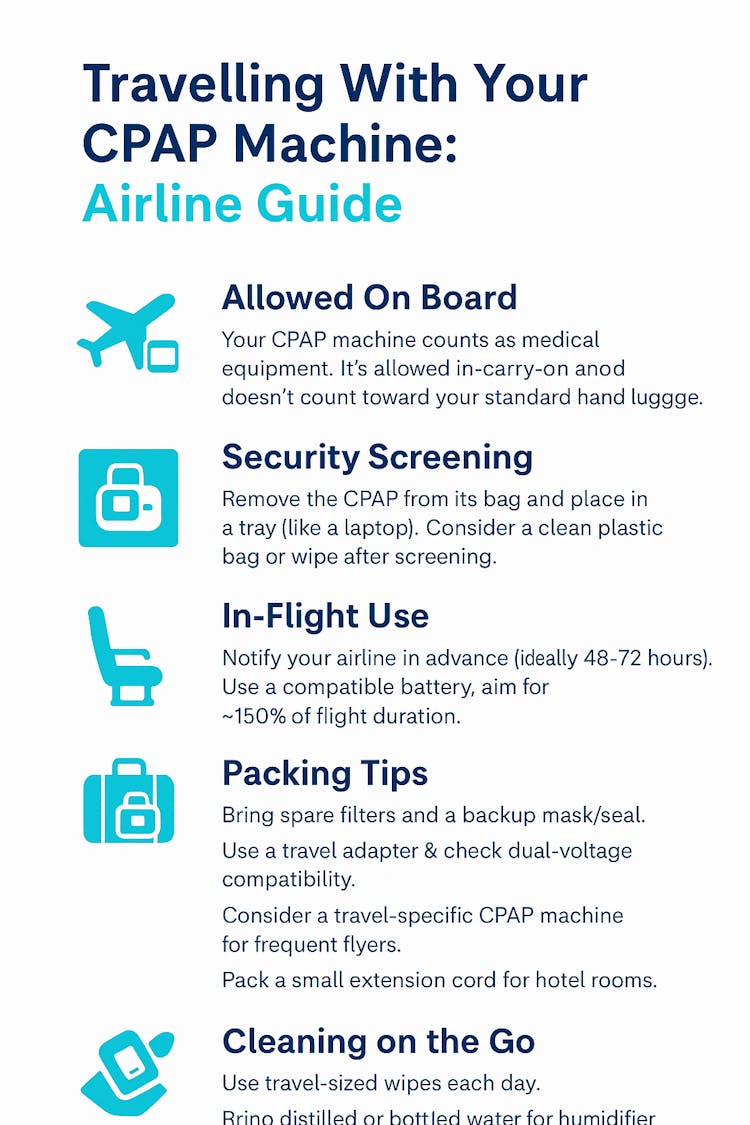How to Travel With a CPAP Machine - A Complete Guide for Flying
For many Australians who rely on CPAP therapy, the idea of travelling—especially flying—can feel stressful
For many Australians who rely on CPAP therapy, the idea of travelling—especially flying—can feel stressful. Questions like “Will my CPAP count as carry-on?”, “Can I use it inflight?”, or “What if security checks it?” are extremely common. The good news is that travelling with a CPAP machine is easier than most people realise.
Below is your complete guide to taking a CPAP machine on an airplane with confidence.

Is a CPAP Machine Allowed on a Plane? Absolutely.
A CPAP machine is classified as a medical device, which means airlines are required to allow you to bring it on board free of charge, and it doesn’t count as part of your carry-on limit.
To make your airport experience smooth, keep the following in mind:
- Most airlines prefer CPAP machines to be carried as hand luggage (not checked), as the device is sensitive.
- Use the manufacturer’s carry case if you have one—this helps identify it as medical equipment.
Going Through Airport Security With a CPAP Machine
Airport security is straightforward, but you should be prepared for:
X-ray Screening
You’ll be asked to remove your CPAP machine from its bag and place it in a separate tray—similar to laptops.
Sanitary Precautions
Because your device will contact shared bins, consider:
- Packing a clean plastic bag to place the machine in
- Wiping down the machine after screening
Documentation
You rarely need documentation, but carrying a short doctor’s note or the device manual can be helpful if any questions arise.
Can You Use a CPAP Machine During a Flight?
The answer depends on your airline.
Some airlines allow inflight CPAP use, provided:
- You notify them in advance (often 48–72 hours)
- Your CPAP machine is battery-powered
- You have enough battery capacity for 150% of the flight duration (a common aviation requirement)
Important Notes
- Do not rely on power outlets on the plane—they’re often limited or incompatible.
- Many CPAP machines have compatible FAA- or CASA-approved batteries.
- Humidifiers may not work properly in cabins due to dry air and turbulence; many travellers use CPAP without humidity while flying.
Always check your specific airline’s policy before your trip.
Packing Tips for Travelling With Your CPAP Machine
- Carry spare filters and a backup mask or seal.
- If you’re travelling overseas:
- Bring a travel adapter suitable for your destination.
- Check voltage compatibility (most modern CPAP machines are dual-voltage).
- Consider using a travel CPAP machine if you fly often—they’re lighter, more compact, and designed for portability.
- Keep a small extension cord handy—hotel power outlets aren’t always beside the bed.
Cleaning Your CPAP While Travelling
Stay consistent with cleaning even while away from home:
- Pack travel-sized wipes for daily cleaning.
- Bring a small amount of distilled or bottled water if you use a humidifier (if not available, using tap water short-term is generally acceptable but clean the chamber thoroughly later).
- Allow components to air-dry during the day.
What If Your CPAP Gets Damaged or Lost While Travelling?
Damaged devices are rare, but to protect yourself:
- Keep your machine with you as carry-on.
- Take photos of the device and serial number before travelling.
- Consider travel insurance that covers medical devices.
If your machine fails on your trip, many suppliers (including some CPAP retailers) can assist with emergency replacement or rental options.
Final Thoughts
Travelling with a CPAP machine doesn’t have to be stressful—thousands of Australians take theirs on planes every day. With a little preparation, you can enjoy safe, uninterrupted sleep no matter where your journey takes you.
If you need help choosing a travel-friendly CPAP machine, airline-approved battery, or simply want packing advice, CPAP Sleep Solutions is always happy to help.